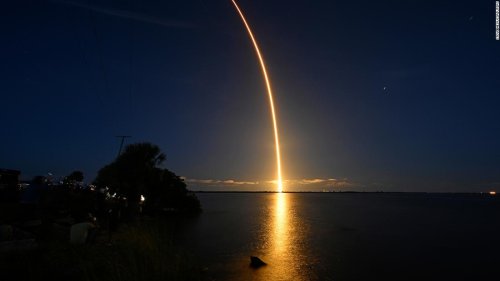An alarm went off on SpaceX’s all-tourist space flight. The problem was the toilet

An alarm began to sound while Jared Isaacman and his three coworkers were free-flying in Earth’s orbit, sheltered from the brutal vacuum of space by nothing more than a 13-foot-wide carbon-fiber capsule.
According to Isaacman, the SpaceX Crew Dragon spacecraft’s systems were notifying the crew of a “serious” problem. They’d spent months going over SpaceX instructions and training to respond to in-space emergencies, so they sprung into action, collaborating with SpaceX ground controllers to identify the source of the issue.
The Crew Dragon, it turned out, was not in danger. The onboard toilet, on the other hand, was not.
Nothing in space, including going to the restroom, is easy. Making sure everything ends up in the toilet is usually an easy goal for a healthy human on Earth. However, there is no sense of gravity in space. There’s no guarantee that what comes out will…go where it’s supposed to go. Waste may — and often do — travel in any way.
Space toilets feature fans within them that create suction to overcome this problem. Essentially, they extract waste from the human body and store it.
And the “waste management system” fans on the Crew Dragon were having mechanical issues. That’s what set off the crew’s alarm.
In an interview with CBS, Scott “Kidd” Poteet, an Inspiration4 mission director who helped manage the flight from the ground, informed reporters about the problem. Poteet and SpaceX’s head of crew mission management later revealed at a press conference that there were “problems” with the waste management system but did not go into detail, sparking an immediate surge of suspicion that the blunder could’ve resulted in a terrible catastrophe.
However, when challenged specifically about it on Thursday, Isaacman stated, “I want to make quite clear: There were no concerns in the cabin at all as it related to that.”
However, Isaacman and his fellow passengers on the Inspiration4 mission had to work with SpaceX to respond to the problem during their three-day stay in orbit, during which they endured many communications blackouts, emphasizing the necessity of the crew’s extensive training program.
“I’d estimate probably around 10% of our time on orbit we had no [contact with the ground], and we were a pretty calm, cool crew during that,” he added, adding that “mental toughness, a good state of mind, and a good attitude” were critical to the operation.
“The psychological aspect is one area where you can’t compromise because…there were certain events that happened up there where if you didn’t have that mental toughness and started reacting negatively, that really could’ve brought down the entire operation,” Isaacman said.
The bathroom incident also underlines a fundamental fact about humanity’s interstellar ambitions: biological realities will always exist, no matter how polished and glamorous we anticipate our space-faring future to be.
A history of excreta in space
When it came to discussing the “bathroom situation,” Isaacman, like many other astronauts before him, was shy.
“No one wants to delve into the nitty-gritty,” Isaacman remarked. “It’s difficult to use the restroom and space, and you have to be extremely — what was the word? — very courteous to one another,” several NASA astronauts told the Inspiration4 crew.
He went on to say that, despite the onboard bathroom troubles, no one injures or humiliated.
“I’m not sure who trained them,” he continued, “but we were able to work through it and get [the toilet] running even in what were originally difficult circumstances, so there was nothing like, you know, in the cabin or anything like that.”
However, figuring out how to relieve oneself properly in space was a vital problem address at the start of human spaceflight half a century ago, and the route to answers was not without setbacks.
According to once-secret government records, on Day Six of the 1969 Apollo 10 mission, which saw Thomas Stafford, John Young, and Eugene Cernan circumnavigate the moon, Stafford reported to mission control that a piece of garbage was floating around the cabin.
“Give me a napkin right now,” the narrator requests. “Here’s another goddamn turd,” Stafford is heard saying a few minutes before Cernan notices another one.
A NASA investigation later showed that the excrement collecting method at the time was a “very simple” plastic bag “taped to the buttocks.”
“The fecal bag system was partially functioning and described by the crew as quite ‘distasteful,'” according to a NASA assessment from 2007. “The bags provided little odor control in the small capsule, and the stink was evident.”
As journalist Mary Roach, author of “Packing for Mars,” told NPR in 2010, “in-space toilets have changed since then, thanks to hard efforts from NASA scientists.”
“The issue is that you have a really complicated space toilet that you need to test. You’ll have to transport it to Ellington Field, board it onto a zero-gravity simulator — a plane that performs these intricate up-and-down arcs — and then find some poor volunteer from the Waste System Management Office to test it. And, I don’t know about you, but doing it on-demand in 20 seconds is putting a lot of strain on your colon. As a result, it is quite complicated and difficult.”
In “Packing for Mars,” Roach says that astronaut potty training is no laughing matter.
“Without gravity, the basic act of peeing can become a medical emergency requiring catheterization and uncomfortable radio consultations with flight surgeons,” she said. It can be difficult to tell when one needs to go because urine behaves differently in different parts of the bladder.
Adapting to the environment
With gravity, oxygen-rich air, and predictable biological cycles, the human body is evolutionarily built for existence on Earth. It is not meant to float disoriented in weightlessness, a feature that has caused several astronauts to feel nauseous to their stomachs, particularly during their first few days in orbit.
NASA astronaut Steven Smith, a veteran of four Space Shuttle flights, told one interviewer, “I vomited 93 minutes into my maiden flight.” “That was the first of a hundred times throughout the course of the four flights. It’s strange going to work knowing you’re going to puke.”
Space Adaptation Syndrome is a phrase NASA has coined for the condition, which it thinks 80 percent of astronauts have had, according to one study.
Isaacman stated that he did not feel the need to puke during the Inspiration4 mission. However, adjusting to microgravity can be difficult.
“It’s just this pooling in your head, like when you’re hanging upside down on your bed,” he explained. “But you have to sort of ignoring it and go through it… It balances out after a day or so, and you don’t notice it as much.”
Not everyone on his crew was as fortunate. According to Isaacman, Hayley Arceneaux, a 29-year-old cancer survivor who served as Inspiration4’s medical officer, had to give Phenergan shots to combat nausea. Phenergan is an antihistamine. Used to treat motion sickness.
The unavoidable truth is that people will continue to suffer from diseases as long as we continue to view space as a destination. That’s why, like Roach, many journalists have questioned our inclination to romanticize space travel while downplaying the hard reality and risks.
Despite the discomfort, Isaacman said he has no regrets about spending almost $200 million on a three-day space mission.
“I hope this serves as a blueprint for future flights,” he added, adding that he believes in SpaceX’s ambition to eventually support entire space colonies.
“I just felt extremely revved up and enthused about the idea that we simply have to keep pushing and going further and further,” he said during his flight.


